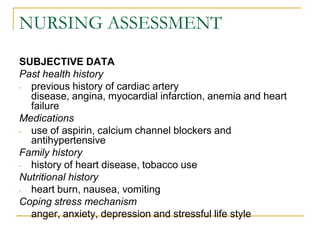Angina pectoris, also known as stable angina, is a type of chest pain caused by reduced blood flow to the heart. It is typically triggered by physical activity or emotional stress, and is relieved by rest or use of medications. Nursing interventions play an important role in managing and treating angina, and can include a range of activities such as patient education, medication administration, and lifestyle modifications.
One of the key nursing interventions for angina is patient education. It is important for patients to understand the cause of their angina, as well as how to recognize the signs and symptoms of an angina attack. This can include information about triggers, such as physical exertion or stress, and how to manage these triggers through lifestyle changes or medication. Patients should also be educated about the importance of seeking prompt medical attention if they experience chest pain, as well as the importance of taking their medications as prescribed.
Medication administration is another important nursing intervention for angina. Common medications used to treat angina include beta blockers, calcium channel blockers, and nitrates. Beta blockers work by blocking the effects of adrenaline on the heart, while calcium channel blockers and nitrates relax the muscles of the heart and blood vessels, improving blood flow. Nurses should ensure that patients understand how to take their medications correctly, and monitor for any adverse reactions or side effects.
Lifestyle modifications can also be an important nursing intervention for angina. This can include encouraging patients to adopt a healthy diet, engage in regular physical activity, and quit smoking. Losing weight, if needed, can also help to improve blood flow to the heart and reduce the risk of angina attacks. Nurses may work with patients to develop an individualized plan for lifestyle changes, including strategies to support behavior change.
In addition to these interventions, nurses may also monitor patients for signs of worsening angina or other complications, and work with the healthcare team to adjust treatment as needed. This may include referral to a specialist or hospitalization if necessary.
Overall, nursing interventions play a vital role in managing and treating angina pectoris. By providing patient education, administering medications, and supporting lifestyle modifications, nurses can help patients to effectively manage their angina and reduce their risk of complications.









